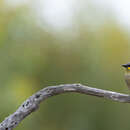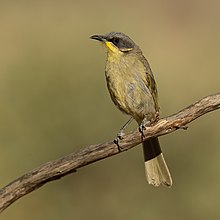zh-TW
在導航的名稱


Aderyn a rhywogaeth o adar yw Melysor ceg borffor (sy'n enw gwrywaidd; enw lluosog: melysorion ceg borffor) a adnabyddir hefyd gyda'i enw gwyddonol Meliphaga cratitia; yr enw Saesneg arno yw Purple-gaped honeyeater. Mae'n perthyn i deulu'r Melysorion (Lladin: Meliphagidae) sydd yn urdd y Passeriformes.[1]
Talfyrir yr enw Lladin yn aml yn M. cratitia, sef enw'r rhywogaeth.[2] Mae'r rhywogaeth hon i'w chanfod yn Awstralia.
Mae'r melysor ceg borffor yn perthyn i deulu'r Melysorion (Lladin: Meliphagidae). Dyma rai o aelodau eraill y teulu:
Rhestr Wicidata:
rhywogaeth enw tacson delwedd Melysor San Cristobal Meliarchus sclateriAderyn a rhywogaeth o adar yw Melysor ceg borffor (sy'n enw gwrywaidd; enw lluosog: melysorion ceg borffor) a adnabyddir hefyd gyda'i enw gwyddonol Meliphaga cratitia; yr enw Saesneg arno yw Purple-gaped honeyeater. Mae'n perthyn i deulu'r Melysorion (Lladin: Meliphagidae) sydd yn urdd y Passeriformes.
Talfyrir yr enw Lladin yn aml yn M. cratitia, sef enw'r rhywogaeth. Mae'r rhywogaeth hon i'w chanfod yn Awstralia.
The purple-gaped honeyeater (Lichenostomus cratitius) is a species of bird in the family Meliphagidae. It is endemic to semi-arid southern Australia, where it inhabits mallee, tall heath and associated low eucalypt woodland.[2]
The purple-gaped honeyeater is a medium-sized (16-19 centimetres) honeyeater which is generally grey-olive above and buffish yellow below.[3] They have a patterned head, with a black eyestripe against a grey background and purple gape above a yellow streak on the throat and pointed yellow ear coverts.[3] Juveniles are similar, but with duller facial patterns, slightly browner plumage, and a yellow gape and gape line.[2] The Kangaroo Island subspecies is considered to be larger and darker than the mainland subspecies.[2]
Similar species include yellow-plumed honeyeater and singing honeyeater.[4]
The song is a clear toweet-toweet-toweet, followed by a high-pitched yep-yep-yep, often performed from a tall branch, including before dawn.[2][4]
They occur in disjunct populations across southern Australia, east from southern Western Australia, with the eastern population largely occurring south of the Murray River, and NSW forming the extreme north-east of its range.[3] Despite its naturally disjunct populations, the purple-gaped honeyeater has very low genetic diversity across its range.[5]
The main habitat type for purple-gaped honeyeater is mallee woodland and shrubland.[4] This includes bull mallee, with patches of green mallee or blue mallee.[4] They also occur in yellow gum woodland with dense thickets of 'totem-poles' or violet honey-myrtle on low-lying flats and gullies in mallee areas.[4] They are occasionally recorded in river red gums bordering waterways,[3] and seasonally in red ironbark woodlands when they are in flower.[4] Purple-gaped honeyeaters can also occasionally be found in gardens.[2]
They are gregarious, usually seen in pairs, or groups of 3-8 birds.[4] Generally considered quiet and unobtrusive, except in spring when they may call often.[4] They are known to regularly drink and bathe, particularly in warmer weather.[4] Purple-gaped honeyeaters associate with yellow-plumed honeyeater and tawny-crowned honeyeater,[4] but can be aggressive towards other honeyeaters,[2] and frequently chase other birds, particularly when feeding.[3]
Purple-gaped honeyeaters feed mainly on nectar and insects,[2] especially from flowering mallee eucalypts,[4] and banksias.[3] They also forage for insects under loose bark on trunks and branches of trees, or catch flying insects on the wing.[4][3] Seeds, pollen and honeydew from scale insects are less frequently consumed.[3]
Purple-gaped honeyeaters build nests as a small cup of bark strips, grass and down, bound with spider web and egg sacs, slung in a horizontal fork or from slender branchlets within dense foliage (usually broombush or eucalypts), normally less than three metres above the ground.[3]
The purple-gaped honeyeater is vulnerable to clearing of mallee, which destroys habitat by removing food plants and nesting sites.[3]
Purple-gaped honeyeaters occur in several protected areas, including:
The purple-gaped honeyeater (Lichenostomus cratitius) is a species of bird in the family Meliphagidae. It is endemic to semi-arid southern Australia, where it inhabits mallee, tall heath and associated low eucalypt woodland.
El mielero de boqueras o melífago de boca morada (Lichenostomus cratitius)[2][3] es una especie de ave paseriforme de la familia Meliphagidae endémica del sur de Australia.
El mielero de boqueras fue descrito científicamente por el ornitólogo inglés John Gould en 1841 como Ptilotis cratitius.[4] Posteriormente fue trasladado al género Lichenostomus.
Se reconocen dos subespecies:[5]
El mielero de boqueras o melífago de boca morada (Lichenostomus cratitius) es una especie de ave paseriforme de la familia Meliphagidae endémica del sur de Australia.
Lichenostomus cratitius Lichenostomus generoko animalia da. Hegaztien barruko Meliphagidae familian sailkatua dago.
Lichenostomus cratitius Lichenostomus generoko animalia da. Hegaztien barruko Meliphagidae familian sailkatua dago.
Punaviiksimesikko (Lichenostomus cratitius)[2] on mesikoiden heimoon kuuluva varpuslintu.
Punaviiksimesikkoa tavataan Australian eteläosissa. Lajia on kuvattu suhteellisen yleiseksi, ja se on luokiteltu elinvoimaiseksi.[1]
Punaviiksimesikko (Lichenostomus cratitius) on mesikoiden heimoon kuuluva varpuslintu.
Lichenostomus cratitius
Le Méliphage grimé (Lichenostomus cratitius) est une espèce de passereau méliphage originaire d'Australie.
Il habite les garrigues australiennes.
D'après Alan P. Peterson, 2 sous-espèces ont été décrites :
Lichenostomus cratitius
 Un méliphage grimé en Australie. Décembre 2019.
Un méliphage grimé en Australie. Décembre 2019. Le Méliphage grimé (Lichenostomus cratitius) est une espèce de passereau méliphage originaire d'Australie.
De purperteugelhoningeter (Lichenostomus cratitius) is een zangvogel uit de familie der honingeters (Meliphagidae).
Deze vogel is endemisch in Australië en telt twee ondersoorten:[2]
De purperteugelhoningeter (Lichenostomus cratitius) is een zangvogel uit de familie der honingeters (Meliphagidae).
Purpurstripehonningeter (Lichenostomus cratitius) er en fugl i gruppen Lichenostomus i familien honningetere. Den er endemisk til det sørlige Australia.
Det er beskrevet to underarter av purpurstripehonningeter[3]:
Purpurstripehonningeter (Lichenostomus cratitius) er en fugl i gruppen Lichenostomus i familien honningetere. Den er endemisk til det sørlige Australia.
Lichenostomus cratitius é uma espécie de ave da família Meliphagidae.
É endémica da Austrália.
Os seus habitats naturais são: matagais mediterrânicos.[1]
Lichenostomus cratitius é uma espécie de ave da família Meliphagidae.
É endémica da Austrália.
Os seus habitats naturais são: matagais mediterrânicos.
Malleehonungsfågel[2] (Lichenostomus cratitius) är en fågel i familjen honungsfåglar inom ordningen tättingar.[3] IUCN kategoriserar arten som livskraftig.[1]
Malleehonungsfågel delas in i två underarter:[3]
Malleehonungsfågel (Lichenostomus cratitius) är en fågel i familjen honungsfåglar inom ordningen tättingar. IUCN kategoriserar arten som livskraftig.
Malleehonungsfågel delas in i två underarter:
Lichenostomus cratitius occidentalis – förekommer i Mallee-området, på gränsen mellan södra och centrala Western Australia Victoria Lichenostomus cratitius cratitius – förekommer på Kangaroo Island (South Australia)Lichenostomus cratitius là một loài chim trong họ Meliphagidae.[2]
Lichenostomus cratitius là một loài chim trong họ Meliphagidae.